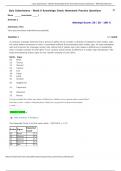Samenvatting
Summary lectures/articles strategic supply chain management!
A summary/transcript of the lectures about all articles from the course strategic supply chain management! Very useful if you want to revise the course material, if you do not have times to watch the lecture video's, or to keep besides the lecture videos to read along with what is discussed!
[Meer zien]













